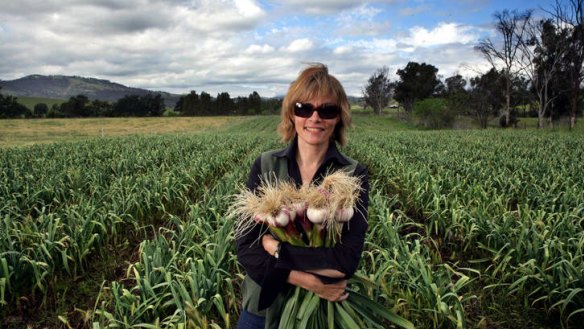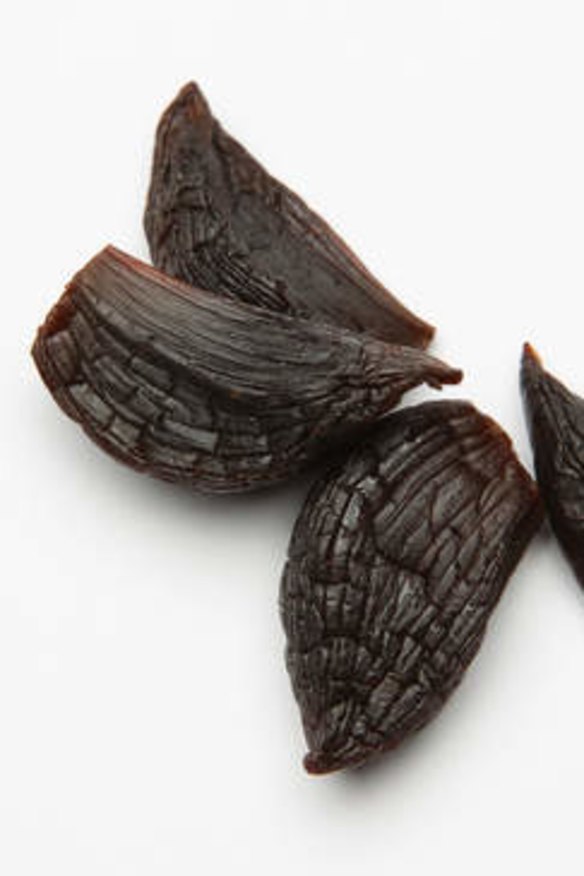Bulbs burn brighter

THERE WAS A TIME WHEN garlic in Australia was not in favour, when restaurants couldn't even use it. Xenos in Crows Nest opened in 1969, and back then ''if there was a whiff of garlic anywhere near the place'', founder Peter Xenos told us, ''they [patrons] wouldn't come in''. Then it began to creep into the Australian kitchen - we were advised to rub a clove around the salad bowl and then throw it away.
But by the time Margaret Fulton's A Passionate Cook was published in 1998, we were happy to cook her ''Shoulder of lamb with two heads of garlic''.
So you'd think there'd be a thriving market for Australian garlic. And there was. Until cheap imports, mainly from China, the source of 70 per cent of the world's garlic, began pouring in about the mid-'90s. Garlic farming is a labour-intensive business, and China has plenty of cheap labour.

Membership of the Australian Garlic Industry Association (AGIA) tells the story. Started 20 years ago, the association had about 700 members at its peak, and then it began to shrink. ''Until two years ago,'' chairman Leon Trembath says, ''there were 19 members. Today, it's up to 78. And we've just launched a website.''
Australian garlic farmers - from big operations such as Nick Diamantopoulos' Australian Garlic Producers, which turns out 1000 tonnes a year and supplies the big supermarkets, to growers such as Jan and Lesley Goroncy, whose Barrington River Organic Farm produces about 700 kilograms a year - are fighting back against cheap imports. And they're by no means the smallest.
Jocelyn Colleron is a small-scale grower - she measures her crop in bulbs, about 4000 - in the Upper Myall Valley near Gloucester. She's also a member of a group of about 15 producers, the Gloucester Garlic Growers. ''We've done trials searching for the best varieties, so growers have more understanding of their characteristics and capabilities,'' Colleron says.
I have seen my market grow with people wanting good flavour.
Trembath says: ''My reading tells me there are approximately 350 different varieties grown in Australia.''
Identifying these varieties, where best they'll grow and their seasons is Colleron's self-imposed task. ''Different varieties will be viable for varying lengths of time,'' she says. ''And that's important if we're to have Australian garlic all year round.''
Colleron organises symposiums on marketing, helps facilitate garlic dinners and can be found at farmers' markets around Sydney offering garlic tastings. Garlic tastings? ''Different varieties of garlic have different flavour characteristics,'' she says. ''And, as with olive oil, there are a whole range of flavours.''
Good Food took part in one of these tastings at the Northside Produce Market in North Sydney. Three samples were offered raw and grated. Our favourite was the small red variety, rojo de pais baza, which had a sweet and savoury flavour.
Some growers, such as Gilles Bonin in Braidwood, concentrate on one variety. Bonin, who began specialising in garlic 20 years ago, began with what is known as Australian white but switched to rocambole, a red variety. ''It's such a nice garlic - not as powerful as the white but with a stronger garlic flavour,'' Bonin says. ''I started with one bulb; now I have 40,000.''
Another pioneer of the Australian garlic renaissance is Patrice Newell, who began much later than Bonin, but is committed. ''It is without a doubt the most obsessive plant to grow,'' Newell says. ''It hooks you. We did our first test lot in 2007, and sold 400 kilograms. Back then, people were busting for [Australian garlic].'' But consumers had to wait. ''Because it's grown as cloves, it's not as quick - you can't just buy seeds,'' she says. ''It took the few people who were trying to grow garlic at the beginning of this century a little time to get the volume up. I think what we're seeing now is the crop of all those growers who were trying to develop their stock.''
Like many growers, Newell has settled on one main variety. ''When Graeme Ayton [her ''garlic guru''] did a test on this variety to see if it would grow well here, it did. We got big bulbs, the flavour was good, our climate suited it. We're on a winner. It's very similar to other purple hard-neck varieties and, for marketing purposes, I call it purple glamour because there's no official varietal register in Australia yet.
''This year I'm not going to grow every variety because in the end, although part of me likes diversity, if you're a commercial grower it's about providing food to people.''
So why should we pay more - between $20 and $40 a kilogram - for Australian garlic as opposed to about $9 for the Chinese product?
First, all imported garlic is sprayed with methyl bromide, an insecticide, fungicide and herbicide. It's often bleached, either with chlorine or a mixture of sulphur and wood ash.
But the main reason is the flavour of the local product. ''I have seen my market grow with people wanting good flavour,'' Bonin says. ''They don't mind paying extra to get a better product.'' An exasperated Colleron says: ''It never ceases to amaze me why people buy imported garlic. It has no flavour.''
Black garlic
Jan and Lesley Goroncy grow Italian purple garlic on their 100-hectare property on the Barrington River. But Jan was looking for something more. ''I thought … 'I'd like to value add'. And that's what took me to black garlic.''
Black garlic (garlic allowed to ferment at high temperatures) is said to have originated in Korea, where it is used as a health supplement. Not surprising. When fermented, one of the sulphur compounds in garlic, S-allylcysteine, an immune-system enhancer, is boosted from 0.322 milligrams a gram to 5.84 milligrams a gram. Calcium and protein are also boosted hugely. Then there's flavour. With a jube-like consistency, cloves of black garlic are syrupy sweet, with undertones of liquorice, and have an overall umami savour.
Jan Goroncy has imported black garlic from Switzerland, both as bulbs and paste, and has begun to experiment with making it himself.
''I knew it needed a consistent high temperature and humidity so I bought a baker's proofer [a box that controls temperature and humidity],'' he says.
The first batch he made was too hard, but a second was closer. And while we're waiting for him to get it right, there's the imported stuff.
Some chefs have already started to use it in Sydney. The head chef at The Woods, Josh Niland, slathers black-garlic butter over wood-fired sirloin - and that's worth a visit on its own.
Garlic season for NSW
September Fresh spring garlic comes onto the market with its long green leaves. Bulbs are forming underground in most crops.
October Harvest is under way. Garlic is cured for a few weeks before it's ready for market. Growers may sell scapes - the fresh inner stalks topped with a bulbil that can be fried, added to soups or steamed.
November Fresh, fully cured garlic is available.
December Peak time for most garlic. More and more cured bulbs and plaits are released.
Where to buy Oz garlic
● Gilles Bonin: gillesaustraliangarlic.com.au.
Bonin will also be at the Sydney Morning Herald Growers' Market on March 2.
● Jan and Lesley Goroncy, for fresh and imported black: barringtonriverorganicfarm.com.au.
● Patrice Newell: patricenewell.com.au.
● Gloucester Garlic Growers: www.gloucester.nsw.gov.au/directory-profiles/gloucester-garlic-growers.
● Australian Garlic Producers: www.australiangarlic.com.au (no sales, information only).
● Australian Garlic Industry Association: garlicaustralia.asn.au.
Restaurant reviews, news and the hottest openings served to your inbox.
Sign up